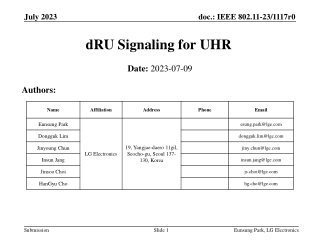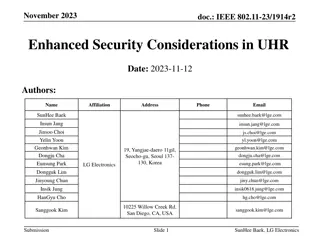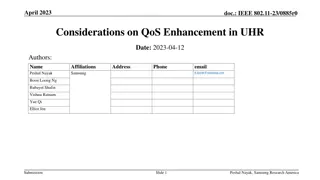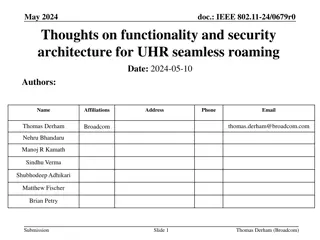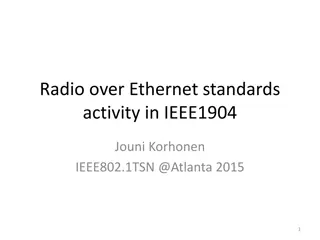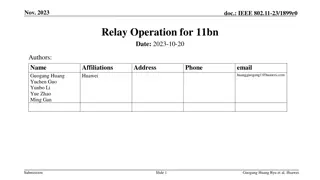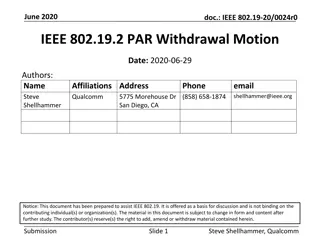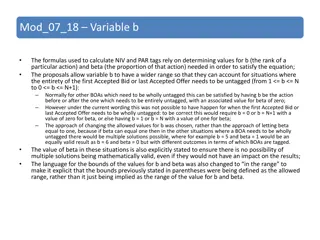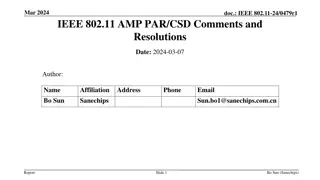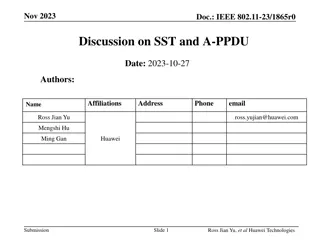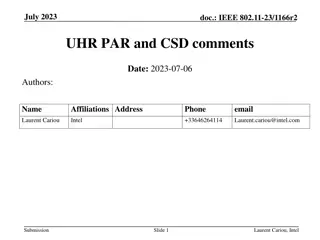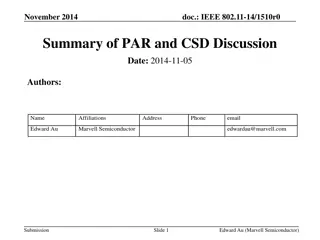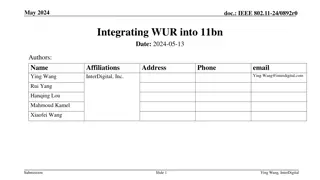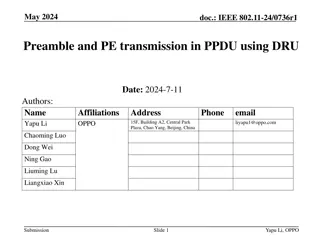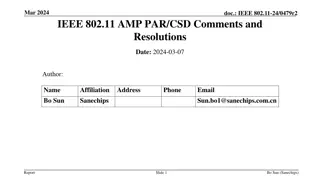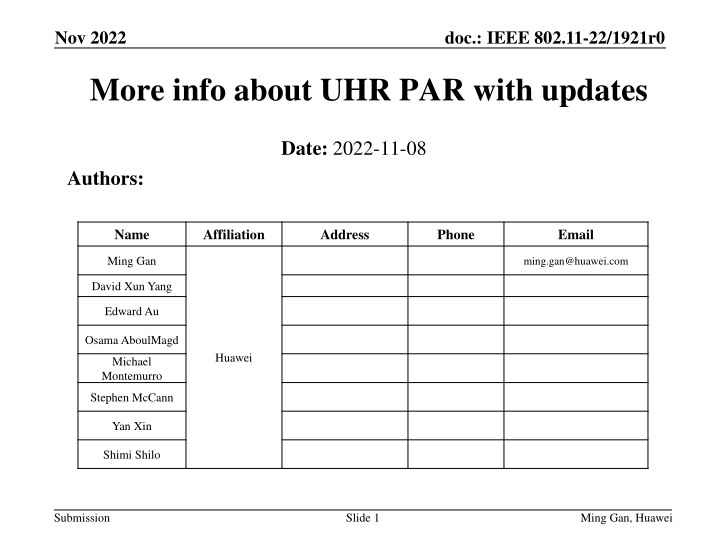
IEEE 802.11-22/1921r0 UHR PAR Updates for Improved WLAN Performance
Explore the latest updates to the IEEE 802.11-22/1921r0 UHR PAR document, focusing on enhancing WLAN performance in terms of throughput, latency, and reliability. Discover the goals for achieving a maximum aggregated throughput of 100 Gbps, reducing latency, and ensuring seamless coexistence with legacy devices. Dive into the proposed improvements for supporting real-time applications and enhancing connectivity across multiple BSSs.
Download Presentation

Please find below an Image/Link to download the presentation.
The content on the website is provided AS IS for your information and personal use only. It may not be sold, licensed, or shared on other websites without obtaining consent from the author. If you encounter any issues during the download, it is possible that the publisher has removed the file from their server.
You are allowed to download the files provided on this website for personal or commercial use, subject to the condition that they are used lawfully. All files are the property of their respective owners.
The content on the website is provided AS IS for your information and personal use only. It may not be sold, licensed, or shared on other websites without obtaining consent from the author.
E N D
Presentation Transcript
Nov 2022 doc.: IEEE 802.11-22/1921r0 More info about UHR PAR with updates Date: 2022-11-08 Authors: Name Affiliation Address Phone Email Ming Gan ming.gan@huawei.com David Xun Yang Edward Au Osama AboulMagd Huawei Michael Montemurro Stephen McCann Yan Xin Shimi Shilo Submission Slide 1 Ming Gan, Huawei
Nov 2022 doc.: IEEE 802.11-22/1921r0 Introduction In the last UHR SG meeting, the scope below was discussed in UHR PAR document[1] Throughput: a) support a maximum aggregated throughput of at least 100 Gbps; b) at least two times improvement in the aggregated throughput for all signal to noise ratio (SNR) levels Improve worst case latency and jitter, satisfying real-time applications requirements Improve reliability of WLAN connectivity Backward compatibility and coexistence: a) enable backward compatibility and coexistence with legacy IEEE 802.11 devices, operating in frequency bands between 1 and 7.250 GHz; b) enable backward coexistence with legacy IEEE 802.11 devices operating in frequency bands between 42.5 and 71 GHz Moreover, throughput, latency and reliability improvement is not only for a single BSS, but also for multiple non-collocated BSSs In this contribution, we provide more thoughts about it and update the corresponding PAR text Submission Slide 2 Ming Gan, Huawei
Nov 2022 doc.: IEEE 802.11-22/1921r0 Throughput Improvement It is feasible to support a maximum aggregated throughput of at least 100 Gbps with the following UHR scenario Band Bandwidth MCS SS # GI Throughput 2.4 GHz 20 MHz 4096 QAM, 5/6 8 0.8 us 1376.8 Mbps 5 GHz 160 MHz 4096 QAM, 5/6 8 0.8 us 11529.6 Mbps 6 GHz 320 MHz 4096 QAM, 5/6 8 0.8 us 23059.2 Mbps 60 GHz (reusing 11ac PHY) 2560 MHz 64 QAM, 5/6 8 0.05 us 83200 Mbps Sum 119.2Gbps Two times improvement in the aggregated throughput, also includes the client s throughput improvement proposed by [2] Bandwidth MCS GI Throughput 2x Throughput SS 11.5 Gbps 320 MHz 4096 QAM, 5/6 2 0.8 5764.8 Mbps Submission Slide 3 Ming Gan, Huawei
Nov 2022 doc.: IEEE 802.11-22/1921r0 Latency and Reliability As reference [3] mentions, reliability should be considered together with the low latency/jitter and mobility. Moreover, both the RTA report[4] and industrial PLC (programmable logic controller) use case[5] propose latency requirements at some certain percentiles Applications Requirements Applications and Class A Class B Class C Interactive video, soft-real- time control, mobile robotics, Automated Guided Vehicles (AGV) 50 -10 ms 99% - 99.9% AR/VR, remote HMI, hard-real-time control, machine tools, production lines 10 1 ms 99.9% - 99.99% Hard-real-time isochronous motion control, printing, packaging 1ms 250 s >99.999% cyclic control, Latency bound Reliability Note-The reliability is defined as the percentage of packets expected to be received within the latency bound. Given the above facts, the PAR section about latency and reliability is updated as following This amendment defines at least one mode of operation capable of improved latency bound and jitter in the 99 to 99.9999th percentiles compared to 802.11be, satisfying real-time applications requirements for high reliability in the presence of overlapping BSSs and for seamless BSS transitions within an ESS. Submission Slide 4 Ming Gan, Huawei
Nov 2022 doc.: IEEE 802.11-22/1921r0 Backward compatibility and coexistence Regarding mmWave bands, it is a good starting point for UHR. Agree to reuse the existing PHY designs to enable mmWave. Reuse 802.11ac numberology with X times upclocking Backward compatibility is not considered within mmWave bands given that the preferred solution is to reuse existing PHY designs On the other hand, energy detection can still be used for coexistence, with limited commercial 802.11ad/ay products (if any). Submission Slide 5 Ming Gan, Huawei
Nov 2022 doc.: IEEE 802.11-22/1921r0 Multi-AP coordination The mmWave band can provide channels with large bandwidths for frequency reuse in dense scenarios. In addition to the use of the mmWave band; multi-AP coordination, such as Co-SR, can also provide minor improvement on frequency use. Hence, the corresponding PAR text is updated as follows, without emphasizing the mmWave band: In addition to further improvements of throughput and latency within a single basic service set (BSS), this amendment also focuses on improving the throughput, latency and reliability of non-collocated multiple non-collocated BSSs in dense scenarios via a) in-band and optionally out-of-band (including via 802.3) AP MLD coordination for interference reduction, and b) the frequency reuse of channels with bandwidths larger than 40 MHz. Submission Slide 6 Ming Gan, Huawei
Nov 2022 doc.: IEEE 802.11-22/1921r0 Summary This contribution suggests some PAR updates, based on the group s recent discussions, proposing that consensus can be reached. Submission Slide 7 Ming Gan, Huawei

